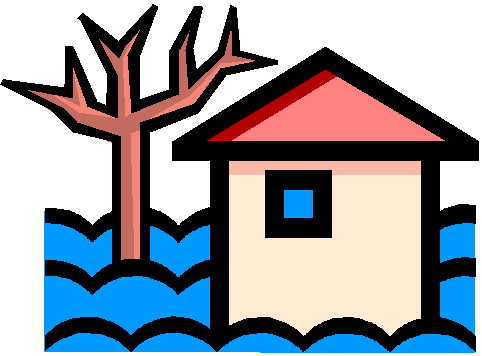Flood Clean-up
Due to the intrusive nature of a flood, we must assume that all flood waters are polluted with sewage.
 As flood waters rise and envelope dry areas, the dry soils used by private sewage disposal systems (Septic Systems) become saturated. With no place for the sewage to go, a septic system may back up into a basement or breakout to the ground surface. Sewage will, in turn, mix with the flood waters either at the ground surface or in flooded basements, and will spread into the surrounding areas. Public sewers may also contribute to sewage in flooded waters. The infiltration of flood waters into sewage manholes or connected storm drains receiving excess flood waters, can eventually lead to the overloading of the public sewer system. This can cause sewage treatment plants to flood and allow the by-pass of untreated raw sewage back into the environment.
As flood waters rise and envelope dry areas, the dry soils used by private sewage disposal systems (Septic Systems) become saturated. With no place for the sewage to go, a septic system may back up into a basement or breakout to the ground surface. Sewage will, in turn, mix with the flood waters either at the ground surface or in flooded basements, and will spread into the surrounding areas. Public sewers may also contribute to sewage in flooded waters. The infiltration of flood waters into sewage manholes or connected storm drains receiving excess flood waters, can eventually lead to the overloading of the public sewer system. This can cause sewage treatment plants to flood and allow the by-pass of untreated raw sewage back into the environment.
Because of this, we advise all residents to stay out of flooded areas. As soon as possible, we will inspect those flooded areas to determine the extent of the flooding and the implications to public health. At that time, a determination will be made as to when it is safe for residents to return.
The following guidelines are designed to help the local officials and residents in the event that a clean-up and disinfection is necessary. If clarification or additional information is required, please feel free to call the North Central District Health Department at (860) 745-0383.
Flood Cleanup
Recommended Guidelines for Clean-Up and Disinfection After Flooding
After natural disasters such as hurricanes, tornadoes, and floods, excess moisture and standing water contribute to the growth of mold in homes and other buildings. When returning to a home that has been flooded, be aware that mold may be present and may be a health risk for your family.
- Flood workers and residents should be cautioned to guard against infection. They should not put their hands near their mouths after handling any possibly polluted surfaces or polluted water until their hands have been washed with soap and clean water. Further, they should not handle food or food products without first cleaning their hands. If a worker or resident is cut by contaminated debris, that resident or worker is advised to contact his physician to determine whether his tetanus immunization is current.
- Flooded cellars: After these are drained or pumped out, wash them down with a hose with clean water and brush and scrub them. Then finish up by applying, with a brush, broom or rags, a disinfecting solution of bleach and water. This can be made up with one cup of bleach in 16 gallons of water (2 ounce/gallon). Do not pour a lot of bleach into a lot of cellar water as the strength of the disinfectant will be rapidly wasted by the dilution. Clean out the cellar or house first.
- Discard whatever cannot be cleaned and dried such as badly soaked mattresses and upholstered material.
- Boil everything that can be boiled such as clothing and bedding.
Clean the following:
Curtains:
- Wash with hot water and soap or detergent when the fabric will not be injured by water, or dry clean.
- Dry thoroughly in open air and sunshine.
- Press with hot iron.
Rugs:
- Flush off with clear water while still on floor.
- Dry thoroughly in sunshine.
- Use a mild soap and lukewarm water to shampoo - then rinse and dry.
Furniture:
- Wash with strong soap and water all surfaces that can be reached and will not be harmed such as wood, metal, leather, cane and composition materials.
- Upholstered materials: Wash whatever materials can be surface-washed and dry thoroughly, preferably in open air and sunshine.
Flooded Clothing: Wash all washable fabrics with hot water and soap or detergent. For fabrics that would be injured by hot water, dry thoroughly, in the sunshine, and sterilize by pressing with a hot iron or by dry cleaning.
Flooded Foodstuffs: No foodstuffs subject to contamination from flood waters should be used unless such foodstuffs have been stored in commercial, hermetically sealed containers, in which case the outside should be thoroughly washed and then sterilized with boiling water or disinfectant. It is best to Apply it safe@ and discard any questionable foodstuffs, including all screw-top and crown-top glass containers, cork bottles and home canned rubber ring sealed jars.